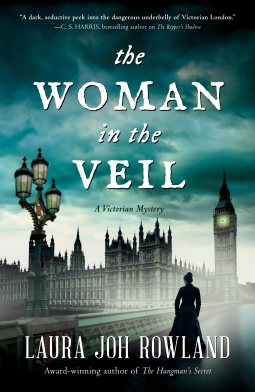
The Woman in the Veil by Laura Joh Rowland
Genre: Historical mystery
Publisher: Crooked Lane Books
Publication Date: January 7, 2020
Summary
Award-winning author Laura Joh Rowland is back with the fourth in her critically acclaimed Victorian mysteries where the case of a mutilated “Sleeping Beauty” washes ashore in London.
London, June 1890.
Sarah Bain and her friends Lord Hugh Staunton and Mick O’Reilly are crime scene photographers for the Daily World newspaper. After solving a sensational murder, they’re under pressure to deliver another big story. On a foggy summer night, they’re called to the bank of the river Thames. The murder victim is an unidentified woman whose face has been slashed. But as Sarah takes photographs, she discovers that the woman is still alive.
The case of “Sleeping Beauty” becomes a public sensation, and three parties quickly come forward to identify her: a rich, sinister artist who claims she’s his wife; a mother and her two daughters who co-own a nursing home and claim she’s their stepdaughter/sister; and a precocious little girl who claims Sleeping Beauty is her mother. Which party is Sleeping Beauty’s rightful kin? Is someone among them her would-be killer?
Then Sleeping Beauty awakens–with a severe case of amnesia. She’s forgotten her name and everything else about herself. But she recognizes one of the people who’ve claimed her. Sarah is delighted to reunite a family and send Sleeping Beauty home–until one of the claimants is murdered. Suddenly, Sarah, her motley crew of friends, and her fiancé Detective Sergeant Barrett are on the wrong side of the law. Now they must identify the killer before they find themselves headed for the gallows. (from Goodreads)
My thoughts
The novel starts off strong. The plot revolves around this “sleeping beauty” and where she belongs. Is it with the rather nasty Mrs. Ester Oliphant and her daughters Frances and Faith? With the tempestuous artist August Legrand? With the precocious (and immensely likable) Venetia Napier and her aunt? It’s an intriguing question, though Sarah and her fiance DS Barrett disagree as to which claimant is the right one.
But there are multiple other subplots, some of which are distracting. After a while, backstory from a previous case threatens to overwhelm the current story. Apparently, a previous novel in the series dealt with the Jack the Ripper case. Sarah’s first person, present tense narrative constantly refers to this case, including in an emotionally tense and meaningful scene near the end. Unfortunately, as I haven’t read that previous book, the significance of this scene is lost for me.
There are lots of things to like about the book, though.
Characters
Sarah is a likable character. As most modern mysteries set in the Victorian era do, the female protagonist holds modern views of sex, gender, race, and sexual orientation. She goes to places where proper Victorian ladies don’t go and holds a job that would make a proper Victorian lady faint in horror. Overall, she’s supposed to be fighting conventional wisdom about women’s place being in the home and all that.
Twenty-first century readers wouldn’t read a novel about a Victorian-era female holding that time period’s prejudices (too offensive for our tastes) or behaving like a “proper Victorian lady” (mostly because a proper Victorian lady would leave the crime fighting to men.)
But Sarah is unusual in that she’s forced by circumstances to work as a crime scene photographer. (Most of these crime-fighting Victorian heroines apparently have no need to work.) This means that she’s not investigating out of boredom or curiosity, but out of necessity; she needs to solve this mystery and get the sensational news story to keep her job. She’s compassionate and fearless and strong-willed.
And she’s a Victorian CSI: how cool is that? I never thought about crime scene photography having a place in investigations prior to the 20th century and it’s fascinating to read about Sarah’s profession.
The other characters are also well-characterized. The new characters seemed a bit more vivid than the returning cast. Venetia, in particular, is a delight to spend time with. It is a lot of fun to root against the awful Oliphants and the equally awful Legrand and hope that all four will get their comeuppance.
Historical details
However, there are times when Rowland explains certain things that avid historical fiction readers should already know. For example, Sarah tells us that homosexual relations are against civil and religious laws, and that exposure in the press would lead to scandals and social ostracism. Maybe I’m wrong, but surely many fans of Victorian-era settings already know this. Do we really need to be told this? Simply showing the effects on Hugh and his lover Tristan is powerful enough.
Because Rowland is excellent at showing this era in all its self-righteous pettiness and squalor. She shows how difficult things were for homosexuals: constant threats of physical harm, vicious tabloid gossip, and an unforgiving social hierarchical system where no one who falls from grace can redeem themselves. She deftly shows the lack of options for women, particularly poor ones. She’s terrific at using time period details for developing characters, advancing the plot, and exposing the prejudices of a society too concerned with appearances and not enough with substance.
Rowland has the ability to recreate a time period so that it lives in our minds. It’s one of her many strengths as a novelists. It’s the reason the Sano Ichiro series (set in feudal Japan) is so beguiling: that series opens the door to a world that many modern Westerners know almost nothing about.
But Victorian England is much more familiar to me. Multiple other mystery series take place in that time period and some feature a female protagonist. Taking this book as representative of this series, I question whether the Sarah Bain series does enough to stand out from the crowd.
Standalone or not?
This is the fourth book in this Victorian mystery series but it’s the first that I’ve read. While I read this book as a standalone, it’s a good idea to to read at least one of the previous books in this series, particularly whichever one delves into the Jack the Ripper case.
Overall, The Woman in the Veil is a good novel. There is a lot to like. Fans of historical mysteries might really enjoy this.
Note: Thanks to Netgalley and Crooked Lane Books for a copy of The Woman in the Veil in exchange for an honest review.

